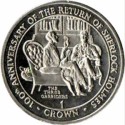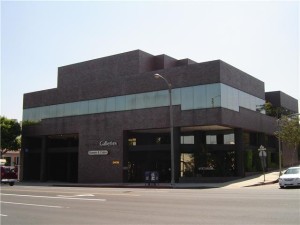A Scion Society of The Baker Street Irregulars

Superior Will Sell Holmes Story About Coin Collector (1995)
” … every corner of the room was stacked with bundles of manuscript …”
– The Adventure of the Musgrave Ritual (MUSG)

This story was originally published in the June 27, 1995 issue of Numismatic News.
“It may have been a comedy, or it may have been a tragedy,” Dr. Watson, venerable biographer of the world’s greatest consulting detective, said at the opening of The Adventure of the Three Garridebs. He would add, it was a case that cost “one man his reason,” himself “a blood-letting,” and another “the penalties of the law.” Sherlock Holmes characterized it as a “whimsical story,” declaring, “I don’t think in all our explorations of human complexities we have ever come upon anything more singular.”
It was also the only mystery of the four novels and 56 short stories that make up the canon (Sir Arthur Conan Doyle’s complete body of work on Holmes) to deal with a coin collector as a mainstay of its theme.
Although this Holmes’ adventure was published more than 70 years ago, it recently came to collector attention of the catalog for the June 24 (1995) Manuscript Auction by Superior Stamp & Coin – An A-Mark Company, Beverly Hills, Calif.
To the delight not only of coin collectors but legions of Sherlock Holmes devotees, Superior’s sale included a rare, handwritten, twice-autographed manuscript for The Adventures of the Three Garridebs, penned by Doyle in 1924 and appearing in the January 1926 issue of The Strand Magazine.
Presented there, and described as having been bound for the author in white cloth, containing his bookplate, it is one of only 13 complete Sherlock Holmes original manuscripts still in existence and one of seven not held by the Doyle family. Including a copy of the 1926 issue of The Strand Magazine, the auction lot was estimated to bring $85,000-$100,000.

For those unfamiliar with story of the three Garridebs, it was June 1902, shortly after the conclusion of the South African War, when Holmes, arising from several days in bed (“as was his habit from time to time”), announced that he had found a way for Watson and him to make some money. He tempted Watson by saying that if they could lay their hands on a man by with the surname Garrideb, there would be money in it. He preferred, however, to leaving the telling of the full story to Nathan Garrideb, who was expected to visit Holmes’ 221-B Baker Street address shortly. Arriving instead, however, was John Garrideb, a lawyer from Moorville, Kan.
Garrideb told of his search for two others by the same last name to fulfill the terms of the will of Alexander Hamilton Garrideb of the United States. Alexander Hamilton Garrideb had made his money in real estate and “in the wheat pit of Chicago,” but had spent much of it purchasing valuable tracts of lan “lying along the Arkansas River, west of Fort Dodge.” Garrideb’s will (“the queerest … that has ever been filed in the State of Kansas”) divided his land holdings into three equal parts – one each for first three male Garridebs who came forward to claim it.
John Garrideb was now at hand, having come by Nathan’s name in a London telephone directory, determined to find a third Garrideb (Nathan had no living male relatives by the same last name) and collect his portion of the property, valued at $5 million. Lawyer Garrideb had also secured agreement from Nathan to purchase Nathan’s bequeathed land at $5 million, should they successfully locate a third Garrideb.
Later that evening, Holmes and Watson went to visit Nathan Garrideb, a loner living on Little Rider Street, “one of the smaller offshoots from the Edgeware Road, within a stone-cast of Old Tyburn Tree of evil memory.” (The site, according to The Annotated Sherlock Holmes by William S. Baring-Gould, of public executions up until 1873).
To the chagrin of numismatists who read Watson’s account of the meeting, Nathan Garrideb, a coin collector with a fascination for ancients of Syracuse and Alexandria, is unflatteringly described as having “a cadaverous face, with the dull dead skin of a man to whom exercise was unknown.” Add to that large round spectacles, “a small projecting goat’s beard” and a “stooping attitude” and you have a man sized up by Watson as “amiable, though eccentric.”
More disturbing than his appearance, however, is that when Holmes and Watson came upon collector Garrideb, he was “holding a piece of Chamois leather in his right hand with which he was polishing a coin.”
In Garrideb’s defense, Baring-Gould explained, in his 1960’s annotation, that there were differences of opinion as to whether or not coin cleaning is proper. Benefit of the doubt, he said, had to be given in calling collector Garrideb (whose house looked like a museum, filled with a variety of collectibles) a numismatist. One Holmes authority Baring-Gould quotes argued that cleaning was all right “to bring out the design,” so long as the coin wasn’t scratched. Collectors of U.S. coins say ouch! Collectors of ancients will be a bit more understanding.
Even with his flaws, collector Garrideb had the noblest of ambitions, hoping to sell his land from the will for the $5 million offered by lawyer Garrideb. He could then, he said, fill in the gaps of his collection, raising it to “the nucleus of a national collection.”
That’s a brief introduction to the story – any more and it would give away too much. As with any Sherlock Holmes mystery, suffice it to say, there are many twists and turns and red herrings, the discoveries of which are better left to the readers. Sum it up simply by saying, as Watson did, that the case was of the utmost importance, as it revealed the depth of Holmes’ true loyalty to him, a revelation “worth a wound – Worth many wounds.”
Collectors not able to bid on the original Doyle manuscript but still wanting to obtain a Holmes’ collectible relating to this case will find one among the 1994 series of coins from Gibraltar issued to mark the centennial of the return of Sherlock Holmes. These first-ever legal-tender coins to honor the famous detective include a one-crown piece for The Adventure of the Three Garridebs, seemingly an “elementary” part of any Holmesean collection.
This story was originally published in the June 27, 1995 issue of Numismatic News.
Postscript: At this auction, The Three Garridebs manuscript was sold to a private collector for $97,750 (including the 15% buyer’s premium), and has remained off the market since that time.
 Robert R. Van Ryzin’s byline has appeared across all of the numismatic periodicals published by Krause Publications and currently serves as the editor of the Bank Note Reporter. Bob is the author of Fascinating Facts, Mysteries & Myths About U.S. Coins, U.S. Coins Close Up, Twisted Tails: Sifted Fact, Fantasy and Fiction from U.S. Coin History, and Crime of 1873: The Comstock Connection, among other titles. The two-volume Annotated Sherlock Holmes is next to his bed, but hasn’t read it lately.
Robert R. Van Ryzin’s byline has appeared across all of the numismatic periodicals published by Krause Publications and currently serves as the editor of the Bank Note Reporter. Bob is the author of Fascinating Facts, Mysteries & Myths About U.S. Coins, U.S. Coins Close Up, Twisted Tails: Sifted Fact, Fantasy and Fiction from U.S. Coin History, and Crime of 1873: The Comstock Connection, among other titles. The two-volume Annotated Sherlock Holmes is next to his bed, but hasn’t read it lately.

Sorry, comments are closed for this post.